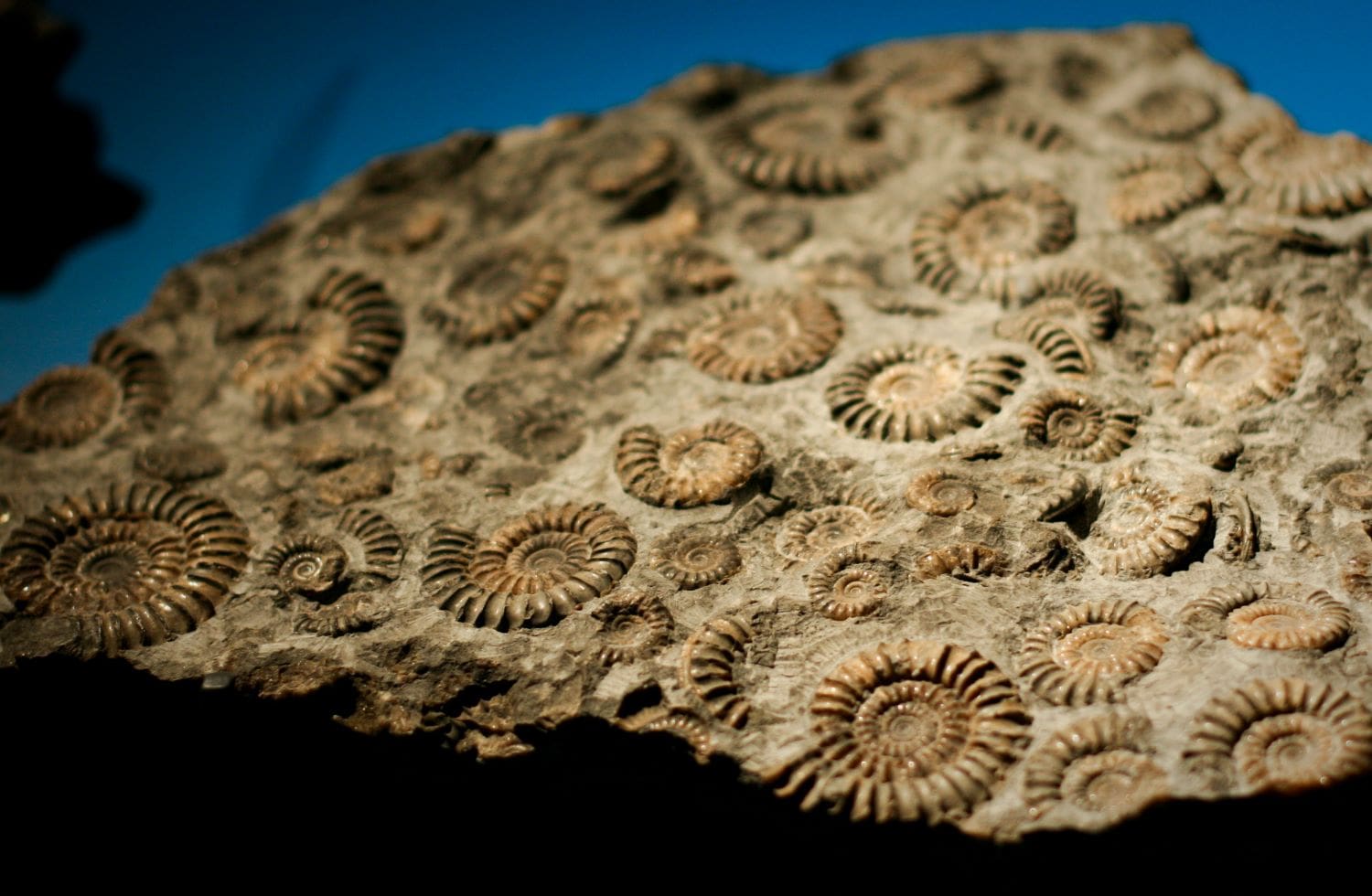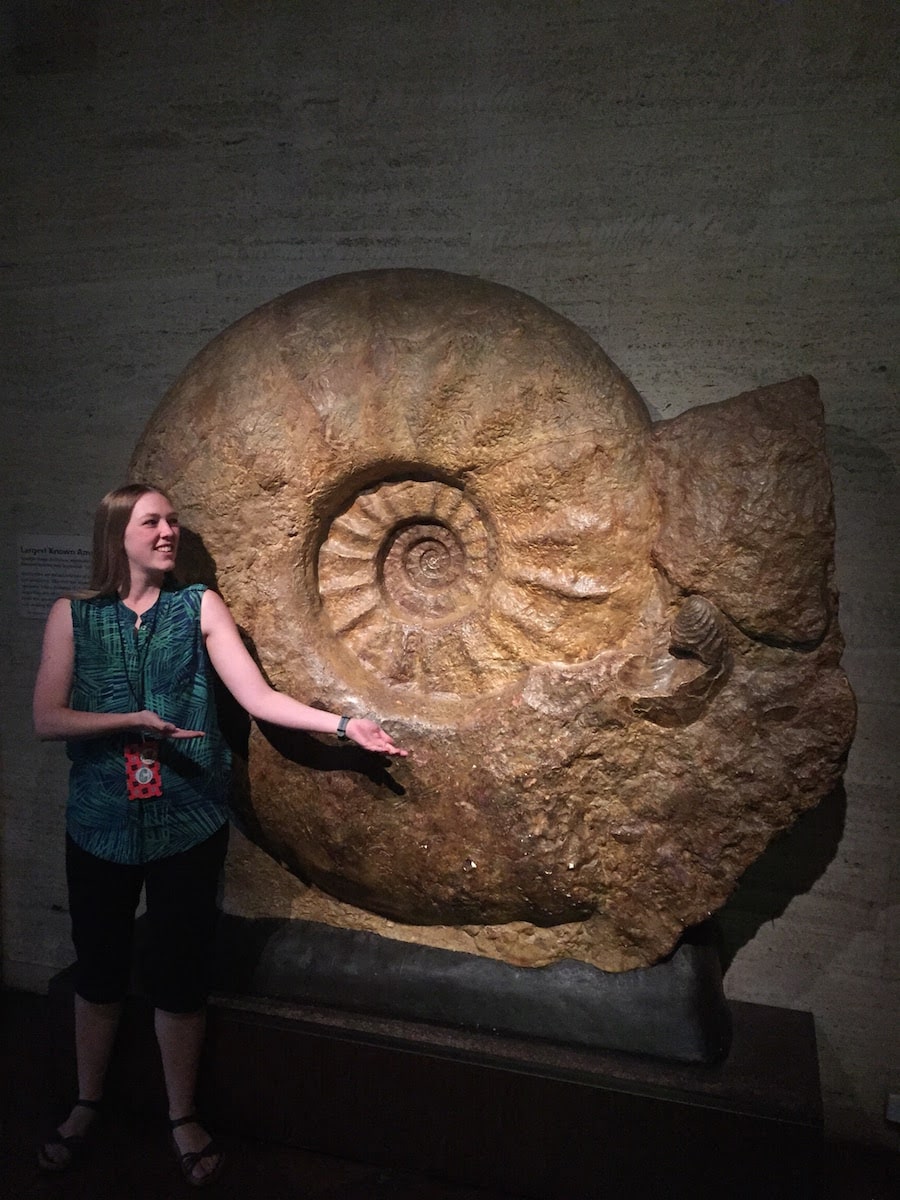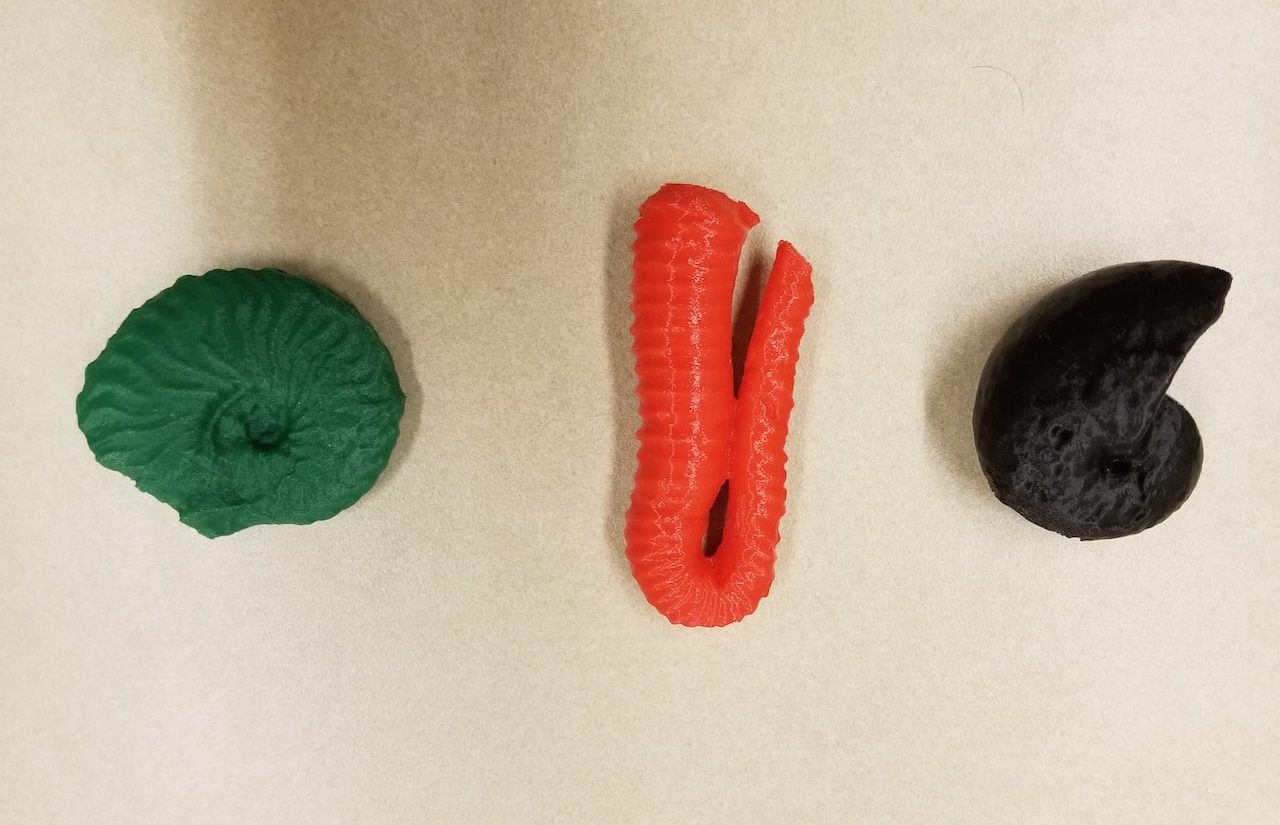The Mysterious Swimming Habits Of The Ancient Ammonite
These extinct shelled cephalopods ruled the ocean for 300 million years. But how they swam and shaped the seas remains a mystery.

"Snake stones" or ancient sea creature? Credit: opacity/flickr/CC BY-NC-ND 2.0
 On the coasts of the English countryside, round, whorled stones can be found embedded in rocks and cliffs. According to legend, the distinct, coiled-up shape has been attributed to the Christian saint Hilda of Whitby, circa 614-680, who was said to have beheaded and petrified swarms of serpents into “snake stones.”
On the coasts of the English countryside, round, whorled stones can be found embedded in rocks and cliffs. According to legend, the distinct, coiled-up shape has been attributed to the Christian saint Hilda of Whitby, circa 614-680, who was said to have beheaded and petrified swarms of serpents into “snake stones.”
But these swirling stones are not reptilian. They’re fossilized shells of a cephalopod that had dominated the ocean during the age of the dinosaurs for about 300 million years.
“If you went to cast a line off a pier during the time of the dinosaurs and try to catch something in the ocean, you’d probably come up with some species of ammonite,” says Kathleen Ritterbush, a paleontologist and assistant professor at the University of Utah. “They were really the deal in cephalopods for a really long time.”
The coiled shell of this now-extinct group of cephalopods, the ammonoids—often referred to colloquially by one of the subgroups, ammonites—is one of the most iconic and common fossils found around the world today. Since they came onto the scene in the Devonian Period about 400 million years ago, the carnivorous ammonoids ruled the Earth’s superocean, Panthalassa from the safety of their twisted shells. They were so successful for long periods of Earth’s history that they were considered a “cosmopolitan” group—readily evolving, diverse, and widespread. And while their fossils may be reminiscent of the chambered nautiluses bobbing around the ocean today, their closest living relatives are squids and octopuses, explains Ritterbush.

After ruling the seas for 300 million years, these influential cephalopods vanished, leaving behind nothing but their distinctive fossils.
“Ammonoids were just everywhere, and we know [little] about what they were doing,” Ritterbush says. “We don’t know how long they lived, if they were smart or stupid, or how fast they could swim.”

Ritterbush is trying to shed some light on their mysterious lifestyle. In her lab at the University of Utah, Ritterbush and graduate student and research assistant Nicholas Hebdon create 3D scans of various shaped shells and simulate how the cephalopod moved through the water. The huge diversity and changes in morphology across the fossil record allows researchers to reach back in time, giving clues about dramatic shifts in Earth’s early marine ecosystems.
“The late Triassic ammonoids are small and scrappy, and their shells are a bit loose,” says Ritterbush. “Then, something really strange happened in the earliest Jurassic, and the ammonoids flourished.”
Within about a million years of the cataclysmic environmental changes from the End Triassic mass extinction, over a hundred known new species popped up around the world’s ocean. Most of the new species of ammonoids shared a similar shell shape, but ranged from the size of a quarter to as large as a car tire, says Ritterbush. Carrying these snake-shaped shells through the water looks like it would have been cumbersome, Ritterbush speculates. She refers to these big, awkward Jurassic ammonoids as “successful slackers.”
“Nobody has any idea what they were doing because that should be one of the crappiest shapes to survive,” Ritterbush says. But, “they were definitely doing great at whatever it is they were doing because they got big.”

The three ammonite shell shapes Ritterbush and Hebdon study, (from left to right) sphereocone, serpenticone, and oxycone. Credit: University of Utah AmmLab
While it’s difficult to study a car tire-sized ammonoid shell in the lab, Ritterbush and Hebdon have found a virtual way to test the physical toll of the massive shells. They currently focus on three shell shapes that were common to ammonoids: oxycones, flat, frisbee shells; spherocones, bulbous round shells; and serpenticones, coiled up cobra-like shells. Drawing upon the plethora of fossils in museum collections, the team models 3D renderings of specimens with a laser scanner.

Ritterbush and Hebdon can either 3D print shells to run physical water flow experiments in a large rectangular, plexiglass flume tank, or place 3D models into software programs that simulate water flow.
“They’re in my desk, they’re in my pocket, they’re in all my bags,” she says. “It’s an immediate way to give somebody the gist of what I’m talking about.”
Despite the printed shells taking over Ritterbush’s lab, computer simulations give her and Hebdon more control over the environment.
“We mainly focus on the virtual right now because it can get us all of the same data and more without some of the challenges, like getting the perfect physical setup, accounting for things like the size of the chamber relative to the size of the object, controlling water speed,” says Hebdon. But, the flume tank experiments are still helpful because “you need to have some real world backdrop that you can compare to to know if you’re doing it correctly.”

This is why the team also runs the ammonoid simulations against models of chambered nautiluses to compare against real-world data, Hebdon explains. The simulations map where the streams of water move around the shell, revealing flowlines, water velocity, and drag, or where the friction from the water is pulling the most on the shell.
“Your speed and shell shape greatly influences how much drag you have,” explains Hebdon. “The faster you try and go, the more force tries to stop you.”
Ritterbush has discovered that each of the three shell shapes have trade-offs between size, shape, and speed. For example, at lower speeds, the frisbee-shaped oxycone and the coiled serpentocone have similar drag. While they both have narrow profiles that helps with decreasing drag, the oxycone is smoother and covers up some of the coils. The serpenticone, on the other hand, has coils that are bumpy like a hubcap, Ritterbush says. That hubcap adds extra turbulence when the critter bolts through the ocean, she says. Meanwhile, the sphereocone shape is prime for super slow movers, she says.
Serpenticone Shell of an Ammonite by created by the University of Utah AmmLab on Sketchfab. View the sphereocone and oxycone 3D models on Sketchfab. All are free and available to download, courtesy of University of Utah AmmLab.
“They’re kind of two themes here,” she says. “Which shape is most efficient depends on the speed you want to go or the size you are.”
Next, Hebdon and Ritterbush are looking at incrementally increasing the width and the amount of coiling of each 3D-modeled shell type to see how they influence drag through the water. They can then take the data and compare it to the most common ammonoid shell shapes found during different points in the fossil record, estimating how well or poorly they swam when ecosystems were thriving or under strife. During the End Triassic mass extinction, for example, chemistry and temperature changes in the ocean put pressure on the ammonoids, causing them to “spend a little extra energy sequestering the ions from which you build your shell,” says Ritterbush.
If the shape of the shells produced by ammonoids is related to their metabolic rates, swimming potential, and position in the food web, it could paint a timeline of marine ecosystems long in the past.
“Based on the [earlier] analyses that I did for the early Jurassic, I think maybe they were slow—they had low metabolic rates,” Ritterbush says. “That could imply there was slower carbon cycling in the early Jurassic ocean, compared to the early Triassic, where they were small and fast, and had a high metabolism. They may have been helping the cycling of an overall faster carbon turnover in the early Triassic.”
And rapidly cycling carbon in a system might support bigger animals and intertwine other ecosystems so that they’re sewn together, explains Ritterbush.
The shape of the shells and the speed not only give hints at when a mass extinction is at play, but tells what the organisms had prioritized to survive in the environment.
“Across the End Triassic extinction boundary, there’s this change of having all kinds of shells to mostly that serpenticone style shell—that coiled up snake—and that shape is interesting because it’s not the most adaptive for going through the water,” Hebdon says. “So if it’s not going for speed, what is it going for?”

Instead of speed, the shell could have served different purposes, such as a protection or buoyancy device, says Ritterbush. The ammonoids, being squid-like, could have combined jet propulsion with the buoyancy of their shells, causing them to putter around more like a hot air balloon than fly like a plane, she explains. But based on the simulations in the lab, Ritterbush suspects otherwise.
“They look like they are just lurking, but whatever lurking they are doing is working for them because they’re big. And you don’t get to be big if lurking wasn’t working.”
Throughout their existence, the ammonoids experienced boom and bust periods. Species snuck through mass extinctions, each time coming back with slight alterations in their shells. “They are absolutely the ‘canary in the coal mine,’” Ritterbush says. “They almost got obliterated from the planet several times.”

The ammonoids met their final fate at the end of the Cretaceous, when they were wiped out alongside the dinosaurs, but their legacy lives on through their strangely twisted shells. They tell the stories not only of Earth’s past, but what could be in store for future marine ecosystems.
“Increasingly, squid and octopus are around all the time in the oceans now, and they’re becoming a bigger and bigger part of day-to-day life in the ocean,” says Hebdon. Studying ammonites “gives us the closest analog we have to an ocean filled with squid and octopuses and cephalopods. Seeing ancient oceans filled with cephalopods might start to inform us of what the dynamics of an ocean ecology are going to look like in the modern world.”
While our oceans might not be at Mesozoic cephalopod population levels just yet, “we are moving into a cephalopod world,” Ritterbush says. These invertebrates are going to play a bigger role in the biogeochemical cycling of the ocean as well as our own economy, she says. Cephalopods’ unpredictable cycles will become even more important to understand.
“Conveniently, we have this 300-million-year set of field notes from an experiment that the Earth ran for us,” says Ritterbush. “If we can read those field notes, can begin to think about some first order lessons and think differently about cephalopods.”
With every donation of $8 (for every day of Cephalopod Week), you can sponsor a different illustrated cephalopod. The cephalopod badge along with your first name and city will be a part of our Sea of Supporters!
Lauren J. Young was Science Friday’s digital producer. When she’s not shelving books as a library assistant, she’s adding to her impressive Pez dispenser collection.